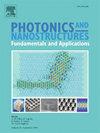Solid nanostructured materials and solar collectors for efficient absorption of intense solar radiation and their application
IF 2.9
3区 物理与天体物理
Q3 MATERIALS SCIENCE, MULTIDISCIPLINARY
Photonics and Nanostructures-Fundamentals and Applications
Pub Date : 2025-05-29
DOI:10.1016/j.photonics.2025.101404
引用次数: 0
Abstract
Solar collectors (absorbers) in which the solar radiation energy is absorbed by liquid working body have been presented in the end of previous century. Optics of pure water and water-based liquids were analyzed for the purpose of their use in solar absorber, but their absorptive properties are not enough to achieve high efficiency of absorbers. After that, various nanoparticles (nanostructures) were used to increase the absortive properies of working liquid absorbers and their optical properties of nanoparticles immersed in water were discussed. Unfortunately, the temperature range in which absorbers with liquid working fluid operate is limited to a value of no more ∼400 K, which, in turn, limits the efficiency of the absorbers. Solid based solar absorbers in which the solar radiation energy is absorbed by solid working body (glass, cermets, ceramics, etc.) have been offered recently. The use of solid-state solar absorbers based on thermal stable solid materials such as glass, ceramics or cermets expands their operating temperature range to 1000 K and more, thereby increasing the efficiency of solar energy collection and opening up the possibility of using high-temperature processes. The optical properties of pure glass and ceramics-based materials are analyzed and the need to use additional absorbers like nanostructures are analyzed. The results of comparative analysis of the influence of optical properties of various metallic and other nanoparticles depending on their material and thermo-optical parameters, solar radiation characteristics and parameters of various hosts (water, glass, Perlucor ceramics) are presented, allowing to select their parameters for increasing the efficiency of solar absorption. Particular interest was shown in the optical absorption properties of homogeneous Ti, Ni nanoparticles in the range of 50–125 nm radii, embedded in silica glass, and they showed the corresponding properties for efficient absorption of solar radiation in the wavelength spectrum of 200–2500 nm. The high temperature stability and efficiency enhancement of solid-state nanostructured materials are significantly higher compared to traditional liquid absorbers, especially taking into account the unique optical properties of Ti/Ni nanoparticles in glass or ceramics. Applications of solid-state solar collectors, thermal energy storage devices, air collectors, as well as solar distillers and desalinators, containing nanoparticles, in various fields are analyzed. Moreover, the high temperature up to thousands of kelvins realized in solid absorbers allows implementing various subsequent high-temperature processes for using the absorbed solar energy. The unique performance advantages of solid absorbers are confirmed by significant achievements currently available. The development and future application of high-temperature nanostructured solid-state solar absorbers promise perspective future effective achievements in different areas.
固体纳米结构材料与高效吸收太阳强辐射的太阳能集热器及其应用
利用液体工作体吸收太阳辐射能的太阳能集热器(吸收器)是上世纪末出现的。对纯水和水基液体的光学特性进行了分析,分析了其在太阳能吸收体中的应用,但其吸收性能不足以实现吸收体的高效率。在此基础上,采用不同的纳米粒子(纳米结构)来提高工作液体吸收剂的吸收性能,并讨论了纳米粒子在水中的光学性能。不幸的是,具有液体工作流体的吸收器工作的温度范围被限制在不超过~ 400 K的值,这反过来又限制了吸收器的效率。固体基太阳能吸收体是一种利用固体工作体(玻璃、陶瓷、陶瓷等)吸收太阳辐射能的太阳能吸收体。基于热稳定固体材料(如玻璃、陶瓷或陶瓷)的固态太阳能吸收器的使用将其工作温度范围扩展到1000 K以上,从而提高了太阳能收集的效率,并开辟了使用高温工艺的可能性。分析了纯玻璃和陶瓷基材料的光学特性,并分析了使用纳米结构等额外吸收剂的必要性。对比分析了各种金属和其他纳米粒子的材料和热光学参数、太阳辐射特性和各种宿主(水、玻璃、Perlucor陶瓷)参数对其光学性质的影响,从而选择其参数以提高太阳吸收效率。在50-125 nm半径范围内,均相Ti、Ni纳米粒子嵌入在硅玻璃中的光学吸收特性得到了特别的关注,它们在200-2500 nm波长范围内表现出了对太阳辐射的有效吸收特性。与传统的液体吸收剂相比,固态纳米结构材料的高温稳定性和效率增强明显更高,特别是考虑到玻璃或陶瓷中Ti/Ni纳米颗粒独特的光学性质。分析了固体太阳能集热器、热能储存装置、空气集热器以及含纳米颗粒的太阳能蒸馏器和脱盐器在各个领域的应用。此外,在固体吸收器中实现的高达数千开尔文的高温允许实施利用吸收的太阳能的各种后续高温工艺。固体吸收剂的独特性能优势已被目前取得的重大成果所证实。高温纳米结构固体太阳能吸收体的发展和应用前景为未来在不同领域取得有效成果提供了前景。
本文章由计算机程序翻译,如有差异,请以英文原文为准。
求助全文
约1分钟内获得全文
求助全文
来源期刊
CiteScore
5.00
自引率
3.70%
发文量
77
审稿时长
62 days
期刊介绍:
This journal establishes a dedicated channel for physicists, material scientists, chemists, engineers and computer scientists who are interested in photonics and nanostructures, and especially in research related to photonic crystals, photonic band gaps and metamaterials. The Journal sheds light on the latest developments in this growing field of science that will see the emergence of faster telecommunications and ultimately computers that use light instead of electrons to connect components.

 求助内容:
求助内容: 应助结果提醒方式:
应助结果提醒方式:


